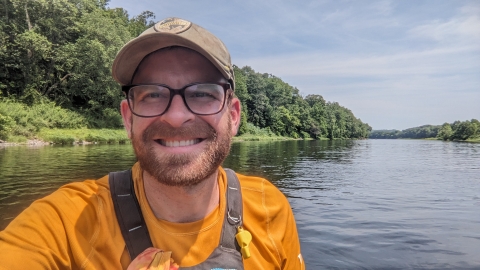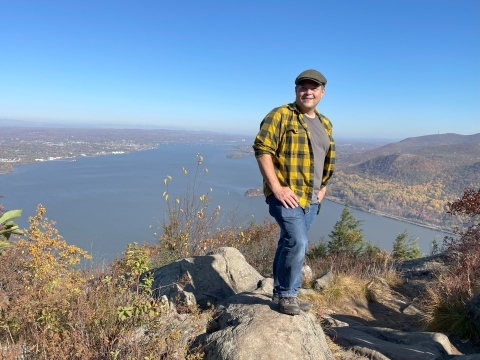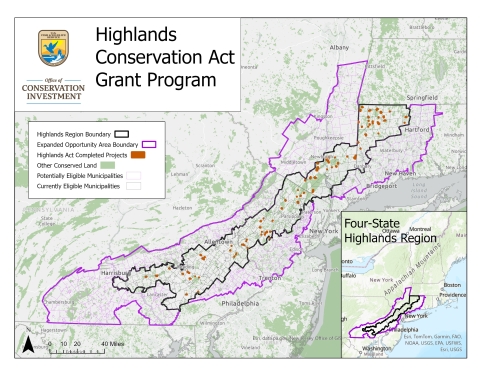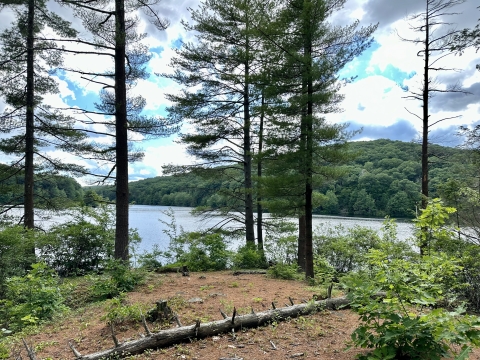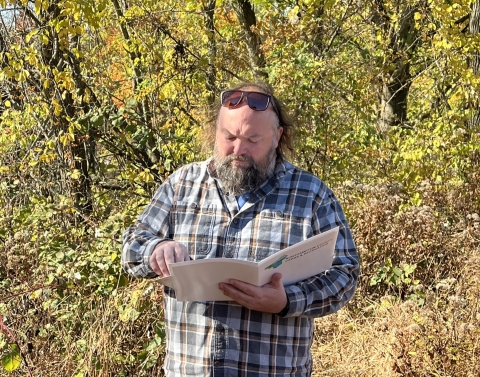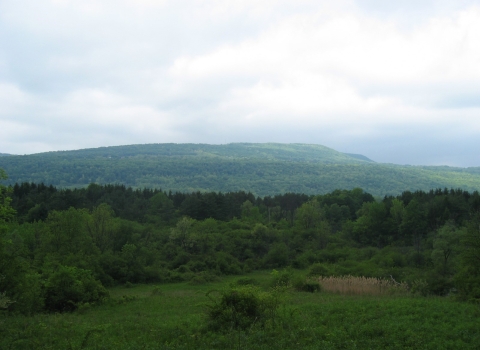Head west from Philadelphia, New York City, or Hartford, and before long, you’ve entered a mosaic of countryside and community, forest and field, mountain and valley, river and lake, past and present. Tens of thousands of years of human activity have shaped this landscape, and nature still thrives.
These are the mid-Atlantic Highlands, an area within 50 miles of more than 10% of the U.S. population, spanning four states.
Since 2004, the Highlands Conservation Act grant program has protected more than 16,000 acres in the Pennsylvania, New Jersey, New York and Connecticut Highlands, putting conservation “on the map” for people and wildlife.
Through grants from the U.S. Fish and Wildlife Service to the states, the Highlands program:
- provides habitat for threatened and endangered species
- protects clean drinking water
- creates outdoor recreational opportunities
preserves working forests and farms
As it marks two decades, the program has an expanded reach and updated priorities for conserving the Highlands region and its benefits to wildlife and people.
A region is born
It began with the fight to save New York’s Sterling Forest, an epic story Mark Zakutansky delights in telling. Now director of conservation policy engagement at the Appalachian Mountain Club and coordinator of the Highlands Coalition, he has worked in the Highlands region for more than 20 years.
In the late 1980s, more than 18,000 acres of woodlands outside of New York City, on the New Jersey border, were slated for development — to be turned into 14,500 homes and five golf courses, serviced by a new exit off I-87. Recreationists and residents alike were horrified.
The New York-North Jersey Chapter of the Appalachian Mountain Club leapt to oppose the project. A group of nonprofit organizations coalesced around the effort, eventually forming the Highlands Coalition.
The watershed surrounding Sterling Forest supplies drinking water for portions of New York City and 25% of New Jersey residents. Fearing the harm development could bring, the states of New York and New Jersey asked Congress to order a study of natural resources in the area, which was completed by the U.S. Forest Service in 1992.
Eventually, the two states and the Highlands Coalition convinced Congress to provide federal Land and Water Conservation Fund money to purchase Sterling Forest and create a state park, the largest addition to the New York State Park system in 50 years.
The Highlands Coalition then set its sights on a broader goal, drafting and advocating for legislation to protect the resources of New Jersey and New York between the mountains and the coast. In 2004, Congress passed the Highlands Conservation Act, designating for the first time the “Highlands region”: 3.4 million acres of Connecticut, New Jersey, New York and Pennsylvania.
“The Highlands Conservation Act created a sense of place, a place that’s real,” Zakutansky said. “There's nothing more important than being on the map.”
Game changer
The Highlands Conservation Act has helped complete 124 land conservation projects that have protected habitat for breeding and migratory birds, resident amphibians and reptiles, and rare plants and communities. Federal funds are matched, dollar for dollar, by state and private funds.
Though often less than half the total project cost, when combined with other funding sources, a Highlands grant can close the deal, either purchasing land outright or buying a conservation easement conservation easement
A conservation easement is a voluntary legal agreement between a landowner and a government agency or qualified conservation organization that restricts the type and amount of development that may take place on a property in the future. Conservation easements aim to protect habitat for birds, fish and other wildlife by limiting residential, industrial or commercial development. Contracts may prohibit alteration of the natural topography, conversion of native grassland to cropland, drainage of wetland and establishment of game farms. Easement land remains in private ownership.
Learn more about conservation easement to prevent future development.
Tim Abbott, conservation director for the Housatonic Valley Association, which works in Connecticut, New York and Massachusetts, is an expert at combining Highlands money with other sources to stretch his organization’s funds. He calls the program a game-changer.
“The Highlands program leverages so much other funding; we rarely are able to do a land protection acquisition with a single source of funding,” Abbott said. “Because we have these federal funds supplementing the state funds, I can raise private funds. Highlands is about one-third of every deal, and it’s an important one-third.”
Abbott believes the Highlands Conservation Act grant program is the “most significant source of federal conservation dollars — even more than the Farm Bill” in northwestern Connecticut and portions of eastern New York, due to “its ability to amplify and enhance really good conservation projects.”
Stretching far and wide
While the original Highlands Conservation Act had plenty of fans and notable accomplishments, its reauthorization in 2022 offered a chance to improve and expand the program. The Highlands Coalition was again instrumental in the process.
A lot has changed in nearly two decades, especially in the field of mapping. While the Forest Service updated the original Highlands maps in 2002 and 2010, technology keeps advancing. In the reauthorized act, Congress approved using the best available science to bring the program up to date. It also made municipal and county governments eligible to receive Highlands funds and conserve land.
We teamed up with more than 200 partners — from state agencies, nonprofits and universities — to prioritize and coordinate on-the-ground conservation in the Highlands region. A new map viewer reflects updated program priorities — climate resilience, habitat connectivity and equitable access to the outdoors — and includes an Expanded Opportunity Area that has the potential to triple the size of the Highlands region.
Reflecting on the changes, Zakutansky said, “The Highlands region is a landscape that’s close to people, where people interact regularly with the landscape. The reauthorization allows us to now protect local parks and stream buffers, in addition to farms and forests. The roadmap was there; we just didn’t have the tools.”
Since the upgrades, 11 Connecticut municipalities have been added to the Highlands program.
“We are thrilled to see expansion of the Highlands region boundary. In Connecticut, we have already protected over 7,000 acres with Highlands funds and the boundary expansion will allow more communities negatively impacted by environmental pollution and historical underinvestment to qualify for this important source of funding,” said Katie Dykes, commissioner of the Connecticut Department of Energy and Environmental Protection. “These open space properties provide free recreational opportunities, connect communities to nature and are paramount to the quality of life for our residents. We are excited for the next 20 years and beyond with this program."
Winchester, Connecticut, is the first environmental justice community to benefit from Highlands funds. One of the state’s most fiscally and economically distressed municipalities, 30% or more of the population lives below 200% of the federal poverty level.
The Service, Connecticut DEEP and the Housatonic Valley Association protected nearly 1,400 acres with a conservation easement on the town’s water company lands. The property will offer both safe drinking water and recreational opportunities to the historically under-resourced community, while also serving as a wildlife corridor wildlife corridor
To maintain healthy species populations and ecosystems, fish and wildlife need the freedom to move and migrate. As habitats and migration routes are affected by climate change and fragmented by roads, fences, energy development and other man-made barriers, wildlife struggle to reach necessary areas to feed, breed and find shelter. A wildlife corridor is a piece of undeveloped land connecting two habitats so wildlife can move safely between them.
Learn more about wildlife corridor .
“Conservation at this scale requires the creativity and commitment of many partners,” Abbott said. “I’m deeply grateful to the Town leadership for pursuing this opportunity, but perhaps even more impressive is the unanimous support that this effort received from Town voters at a Selectmen’s meeting to approve the transaction.”
Conservation cornerstone
In Pennsylvania, the Highlands region sits in the southeastern corner, home to 75% of the population and, until recently, the least amount of state forest land. Highlands grants have made the difference.
The Department of Conservation and Natural Resources matches Highlands funding with Keystone Recreation, Park and Conservation Fund money collected on state real estate transfers. The program has also strengthened relationships between state agencies and land trusts.
“The Highlands program is a cornerstone funding piece for our land conservation efforts in southeastern Pennsylvania,” said Tom Ford, director of the Bureau of Recreation and Conservation at the Pennsylvania Department of Conservation and Natural Resources. “We’ve been able to put assets where the people are and provide recreation close to home.”
The state’s southeastern forest district is no longer its smallest.
“These are areas that are great for recreation because they’re close to where people live,” said Dan Pierce, Highlands program specialist at the Pennsylvania Bureau of Recreation and Conservation. “You can drive 15-to-20 minutes and be in an awesome area, then get out quickly and be back for dinner.”
Thanks to the Expanded Opportunity Area, the Highlands region now reaches west, beyond the Susquehanna River, covering about 20% of the state. The state recently purchased a parcel in York County that will become a county park, now possible due to the grant program’s new guidelines.
“The new guidelines are game changers; they’re phenomenal,” Ford said. “They expanded our opportunities and allow us to touch more people. The majority of outdoor recreation doesn’t occur on state park and state forest land; it happens on local parks.”
Pierce hopes to use Highlands funds to join the South Bethlehem Greenway with the Saucon Bike Trail in the state’s Lehigh Valley, closing a mile-long gap in the trail network. The result would be 13 miles of continuous, off-road multi-use trail that connects to the D&L Trail in Bethlehem, an under-resourced community with few recreational opportunities.
Focused on the future
Congress put the Highlands region on the map 20 years ago and broadened its boundaries — geographic and social — in 2022. Now, the Highlands Conservation Act grant program is equipped to take on some of our most pressing concerns.
“In many ways, the Highlands Conservation Act as it functions is an exemplary public/private partnership — the sort that taps into a whole nonprofit sector and a whole academic sector, as well as different levels of government,” Abbott said. “That’s hopeful; that means that the kind of projects we do are meaningful where people live, are meaningful for the resources we’re trying to conserve, and are flexible enough to respond to new threats and opportunities.”
Continue reading about the Highlands Conservation Act’s history and success




